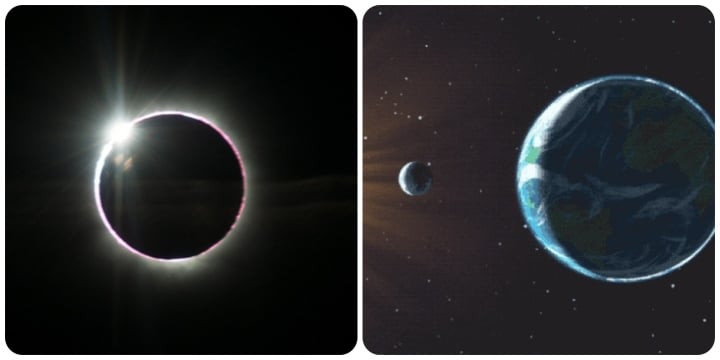What is a solar eclipse?
A solar eclipse occurs when the moon passes between the sun and the earth. When viewed from earth, the moon partially or completely covers the sun.
Specifically, the Earth moves around the Sun while the Moon moves around the Earth. Each cycle, the Moon enters a position between the Earth and the Sun once. However, because the two orbits are about 5 degrees apart, the Moon does not always cross the line connecting the Earth and the Sun. In other words, many times the Moon enters the "new moon" moment, and only once on a moonless night does the 3 celestial bodies (Sun - Moon - Earth) align.

What is a solar eclipse?
How many types of eclipses are there?
There are four basic types of solar eclipses. The first is a partial eclipse, when only the Moon's outer shadow, called the penumbra, interacts with the Earth. From within the penumbra, only the part of the Sun that is covered by the Moon's disk can be seen.
Next is a total solar eclipse, in which a total solar eclipse can only be seen from within the moon's shadow cone, called the umbra.
An annular solar eclipse, or "ring of fire" eclipse, is so called because the moon is too far away and therefore too small to cover the sun. So a ring of sunlight is still visible around the edge of the moon. For the shadow to reach Earth during this type of eclipse, the moon must be closer than its average distance.
Finally, there is a hybrid eclipse. This is a very rare phenomenon. A hybrid eclipse usually occurs when an annular eclipse transitions into a total eclipse.
Of all the above, hybrid eclipses only account for 4.8%. In the 21st century, there will be only 7 hybrid eclipses. And one of them will take place tomorrow, April 20, 2023.
Thanh Thanh (Synthesis)
Useful
Emotion
Creative
Unique
Wrath
Source




















































![[Maritime News] More than 80% of global container shipping capacity is in the hands of MSC and major shipping alliances](https://vphoto.vietnam.vn/thumb/402x226/vietnam/resource/IMAGE/2025/7/16/6b4d586c984b4cbf8c5680352b9eaeb0)













































Comment (0)